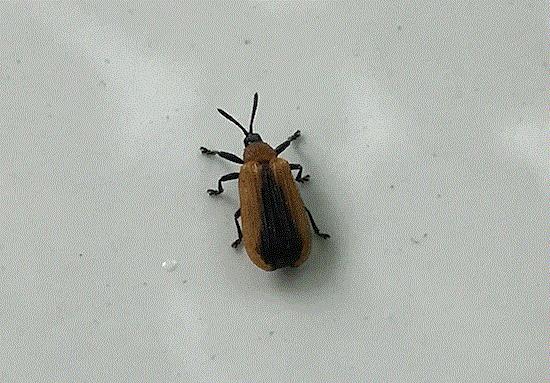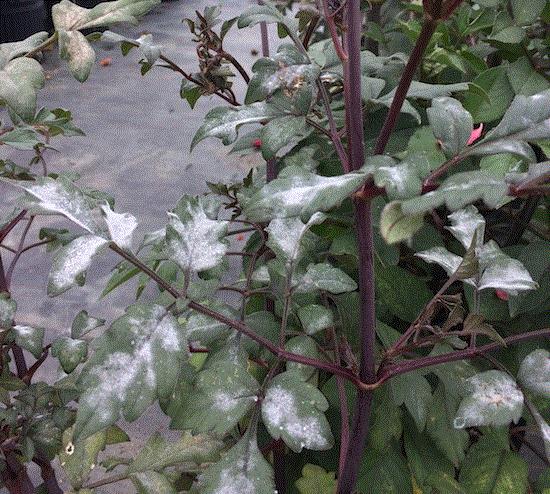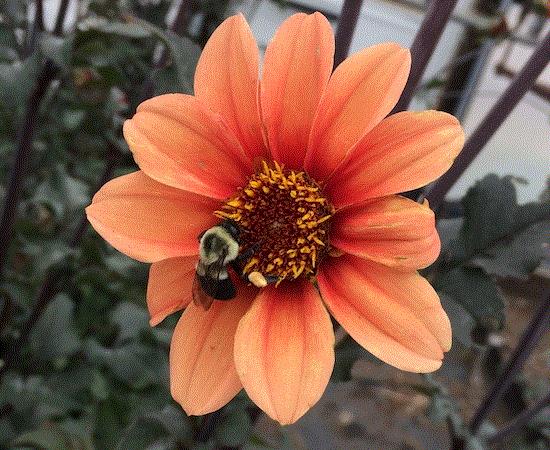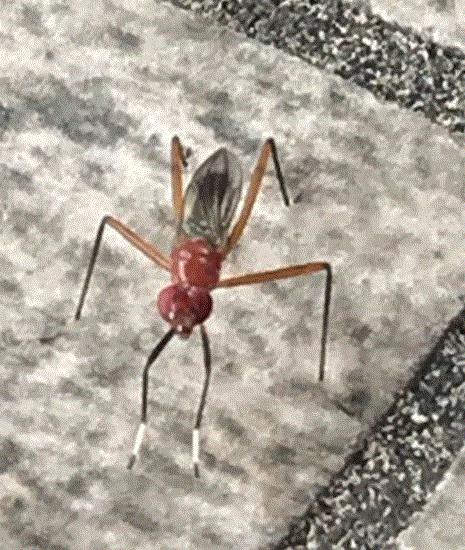What the ... ?
Amanda Sabo of Snow Creek Landscaping sent me a picture of a critter a month ago. She reported that the insect was devouring her client’s yellowwood tree. I looked at the picture, and then I looked at it some more and scratched my head. I’ve seen that before, but what the … is it?
A few colleagues and I did some educational programs with lightning bugs (or what some of y’all call fireflies) a couple of years ago. I’m familiar with lightning bugs, and their close relatives, the net-winged beetles. At first, I thought what’s in the picture is a net-winged beetle because of a similar shape and texture on the elytra. But, wait! The feet (or tarsi, for y’all who are a bit pedantic) look different from those of a net-winged beetle; they are more like those of a leaf beetle. What the … is it?

I thought I'd seen this one before ... (Photo credit: Amanda Sabo, Snow Creek Landscaping)
I had to call in the big guns. I sent the picture to Mike Caterino at Clemson University, who specializes in beetles. I got an answer within minutes—the locust leaf miner, Odontota dorsalis. Again, it proves my point—you don't have to know everything as long as you know who to call!
It makes sense that the locust leaf miner would attack yellowwood, which is related to locust. The beetle prefers black locust and honeylocust, but will also attack apple, beech, birch, cherry, elm, oak and hawthorn on occasions. Adult beetles skeletonize the leaves, while the larvae mine between the leaf surfaces.
This species is widely distributed in the eastern U.S. There are two generations. Adults are ¼ inch long, and their bodies are yellow on the edge and black in the middle. They are active in May and August, and lay eggs on the underside of leaves. The hatchlings first feed together in the same blotch mine. When they get a bit older and start to bicker with their siblings, they will move out of the communal house and establish their own mines. The larvae then pupate in the mines. The damaged leaves don't fall off the tree, so a severe infestation often makes the tree look brownish or bronze.

An adult locust leaf miner and skeletonized leaves. (Photo credit: Laurie Reid, formerly of the South Carolina Forestry Commission)
I like how a U.S. Forest Service bulletin describes the outbreaks of this beetle as “generally more spectacular than destructive,” and suggests that control is generally not necessary. I certainly agree that no management is needed for mature, well-established trees. Management may be needed for severe infestation and smaller or recently transplanted trees. In my experience, pyrethroids usually work quite well against leaf beetles. Keep an eye on the trees after treatment because reapplication may be needed when the beetles return. Systemic insecticides applied to the root zones don’t work particularly well against leaf beetles in my experience.
Watch for powdery mildew
Powdery mildew is whooping my tail right now. I grow a large group of dahlias for a USDA-SCRI pollinator research project. I’m proud to say that my dahlias are the absolute darlings of bumblebees and other native bees, but these bees are interfering with my research! I collect pollen from the dahlias for insecticide residue analysis, and the bees are stealing my goods. Don’t worry, I haven't treated the plants. I’m collecting some untreated pollen for baseline data at this time. I need to find a way to keep the bees out before I apply insecticides, while maintaining airflow through the hoophouse.


Now, back to powdery mildew. I think airflow is my biggest problem. High humidity and condensation (after our recent downpour) foster powdery mildew. Despite having the side panels completely down, it’s still pretty darn hot and humid in the hoophouse. I’ll need to space the plants out (I guess some will have to go to another hoophouse) and run extra fans to keep the air moving. I’ll also have to remind my helpers to watch their irrigation patterns and amount to avoid making the place even more humid.
When I was growing tropical soda apple for a biological control project in Florida, I'd control powdery mildew quite successfully with a spray of baking soda (sodium bicarbonate). I have some MilStop (85% potassium bicarbonate) in my chemical storeroom, so I’ll use that.
Fungicides in FRAC Group 11 (the QoI fungicides or the "strobis"), such as azoxystrobin (Heritage), fenamidone (FenStop), fluoxastrobin (Fame), kresoxim methyl (Cygnus), pyraclostrobin (Empress Intrinsic) and trifloxystrobin (Compass), are very effective against powdery mildews. The FRAC 7+11 (Broadform, Mural, Orkestra Intrinsic and Pageant Intrinsic) or 11+3 combination products (Fame+T and Trigo) are also effective. But the strobis are notorious for their high risk of resistance development, so you’ll need to rotate Group 11 fungicides with other modes of action, such as thiophanate methyl (FRAC 1), the DMI fungicides (3; imazalil, metconazole, myclobutanil, propiconazole, tebuconazole, triadimefon, triflumizole, triticonazole), piperalin (5), polyoxin D zinc salt (19), copper salts (M1), mancozeb (M3), chlorothalonil (M5), myclobutanil + mancozeb (3+M3), and propiconazole + chlorothalonil (3+M5). Refer to product labels and the 2019-2020 GrowerTalks Insecticide, Miticides, & Fungicide Guide for application details. I have potassium bicarbonate, azoxystrobin, macozeb and copper sulphate pentahydrate in my storeroom; there, that’s my rotation program.

New crop safety summaries from IR-4
Speaking of azoxystrobin, IR-4 released an azoxystrobin crop safety summary two weeks ago, along with those of two other fungicides and three insecticides.
Azoxystrobin (Heritage) was introduced to the turf industry in the U.S. in 1997, and the ornamental industry in 2003. IR-4 conducted 107 trials to evaluate the crop safety of azoxystrobin on 77 ornamental plant species between 1999 and 2014. Only two species (Douglas fir and western hemlock) exhibited slight injury and growth reduction when drenched at 2 and 4 oz. per 100 gallons. IR-4 recommends that 54 woody and herbaceous species be added to the tolerant plant list on the label of Heritage. Access the azoxystrobin crop safety summary here.
Azoxystrobin + difenoconazole (originally named Alibi Flora) is not currently available to ornamental plant production. Quadris Top contains the same combination of active ingredients and it’s registered for use on vegetables, fruits, tree nuts and certain field crops. Briskway is registered for golf course turfgrasses. Between 2014 and 2016, IR-4 conducted 41 crop safety trials on 15 ornamental plant species. The rates tested were 8 (high label rate), 14 and 28 fl. oz. per 100 gallons. Eight taxa (Aquilegia, Buddleia davidii, Calibrachoa, Dianthus, Lamium, Lavandula, Monarda and Osteospermum) exhibited no injury. Access the crop safety summary here.
Cyflufenamid is a foliar disease fungicide not yet registered with EPA. Thirty-nine crop safety trials were conducted on 16 species, and none of the tested plant species exhibited injury at 1.7, 3.4 and 6.8 oz. per 100 gallons. Additional studies will be conducted to further evaluate the crop safety of cyflufenamid. Access the cyflufenamid crop safety summary here.
Pyridaryl (Overture) is an effective insecticide against thrips and caterpillars, and it is registered for use in the greenhouse only. This insecticide was introduced in 2008. Between 2010 and 2015, IR-4 conducted 51 crop safety trials on 12 plant species. None of the plant species exhibited injury after three foliar applications at 8 (the label rate), 16 or 32 oz. per 100 gallons. Access the pyridaryl crop safety summary here.
Pyrifluquinazon (Rycar) was introduced in 2013 for control of aphids, whiteflies, mealybugs, leafhoppers and thrips. The label rates range from 1.6 to 6.4 fl. oz. per 100 gallons. IR-4 conducted 131 trials on 29 plant taxa between 2010 and 2016. No plant species exhibited injury, although additional crop safety data for coreopsis, dianthus, gardenia, hibiscus, hydrangea and roses are still needed. Access the pyrifluquinazon crop safety summary here.
Tolfenpyrad was first introduced as Hachi-Hachi 15 EC in 2010, and then as Hachi-Hachi SC in 2015. Hachi-Hachi SC is registered for management of aphids, leafhoppers, mealybugs, soft scales, whiteflies, thrips and young caterpillars in greenhouse and outdoor production (California allows greenhouse use only). Twenty-six plant taxa were evaluated for crop safety of Hachi-Hachi SC. Twenty taxa exhibited no injury, but impatiens and New Guinea impatiens were sensitive. These two taxa have already been included on Hachi-Hachi SC’s sensitive plant list, along with Salvia and Gypsophila spp. Additional data are needed for coreopsis, dianthus, Dendrobium densiflorum and sage. Access the tolfenpyrad crop safety summary here.
I mentioned in April 2018 that Hachi-Hachi is now registered in California. At that time I didn't know why Hachi-Hachi, which means “88” in Japanese, is named so. Mark Brotherton of SePRO later educated me that “88” is a lucky number for the Japanese. Duh! “88” holds the same meaning for the Chinese! How could I forget that?

Fly on stilts
I LOVE getting a picture from one of my friends in the field. I can be official and say it’s my duty as an extension educator to help. But, the truth is, getting these pictures is like getting a “get out of jail free” card. The “jail” being the drudgery of scientific manuscripts, grant proposals, accomplishment reports, etc. that chain me to my computer. So, thank you!
Many pictures I receive are of serious pest infestations, such as an undulating lawn that was composed entirely of marching fall armyworms. Sometimes, they’re something I haven't seen before, such as Amanda’s locust leaf miner or, more recently, fire ants girdling a hemp stem. Who knew?
The most fun of them all are just curiosities. Darren Wentz of Earth Keeper Lawn Care recently sent me a picture taken by his client, Donna Rogers, at Myrtle Beach. It shows a Grallipeza nebulosa resting on a back patio. This is a wonderful, beautiful and common stilt-legged fly of the southeastern U.S. Not much is known about this species. The larvae likely feed on decaying organic matter. Adults often rub and wave their long, white-banded front legs, perhaps mimicking the waving antennae of wasps. Getting something like this is just plain fun!

A stilt-legged fly. (Photo credit: Donna Rogers)






See y'all next time!

JC Chong
Associate Professor of Entomology at Clemson University
This e-mail received by 25,155 subscribers like you!
If you're interested in advertising on PestTalks contact Kim Brown ASAP!